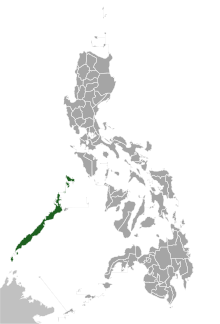
Hornbills are birds found in tropical and subtropical Africa, Asia and Melanesia of the family Bucerotidae. They are characterized by a long, down-curved bill which is frequently brightly coloured and sometimes has a horny casque on the upper mandible. Hornbills have a two-lobed kidney. They are the only birds in which the first and second neck vertebrae are fused together; this probably provides a more stable platform for carrying the bill. The family is omnivorous, feeding on fruit and small animals. They are monogamous breeders nesting in natural cavities in trees and sometimes cliffs. A number of mainly insular species of hornbill with small ranges are threatened with extinction, mainly in Southeast Asia.
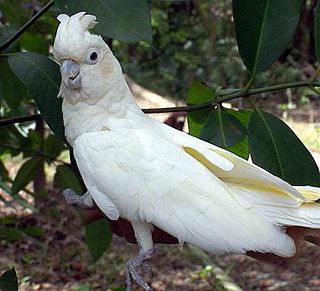
The red-vented cockatoo, also known as the Philippine cockatoo and locally katala, abukay, agay, or kalangay, is a species of cockatoo. It is endemic to the Philippines, formerly found throughout the entire country, but due to the illegal wildlife trade, it is now locally extinct in most of its range with the only sizeable population remaining in Palawan and Sulu Archipelago. Remnant populations occur in Polillo Islands, Bohol, and Samar. It is roughly the size and shape of the Tanimbar corella, but is easily distinguished by the red feathers around the vent. It is threatened by habitat loss and the cage-bird trade.
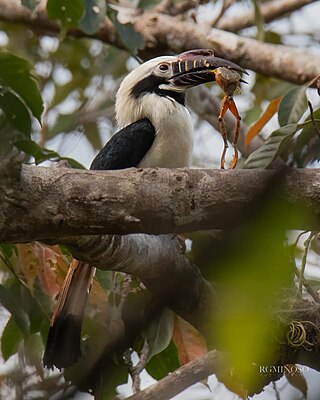
The Visayan hornbill is a hornbill found in tropical moist lowland forests of the Philippines in the Western Visayas region which includes the islands of Panay, Negros and formerly as well as the island of Masbate, and formerly Ticao, in the Philippines. As is the case with all five Philippine tarictic hornbills, formerly considered to be just one species.It is declining due to habitat destruction, hunting and the illegal wildlife trade.

Walden's hornbill locally called dulungan, also known as the Visayan wrinkled hornbill, rufous-headed hornbill or writhe-billed hornbill, is a critically endangered species of hornbill living in the rainforests on the islands of Negros and Panay in the Philippines. It is closely related to the writhed hornbill, but can be recognized by the yellow throat and ocular skin in the male, and the blue throat and ocular skin in the female. Its binomial name commemorates the Scottish ornithologist Viscount Walden.

The Mindanao hornbill, also known as the Mindanao tarictic hornbill, is a medium-small species of hornbill found in the canopy of rainforests on Mindanao, Dinagat, Siargao and Basilan in the southern Philippines. All five Philippine tarictics were once considered a single species. Its population declining due to habitat destruction, hunting and the illegal wildlife trade.

The Puerto Princesa Subterranean River National Park is a protected area in the Philippines.

The Palawan peacock-pheasant is a medium-sized bird in the family Phasianidae endemic to the island of Palawan in the Philippines. The spectacular male has a black body with blue marks on the wings, a grayish, finely speckled back and tail with blue peacock “eyes,” white marks on the face, and a red eye-ring. Females are mostly brown but with a white face. It is known as tandikan in the some local Palawano, Tagbanwa, and Batak languages of Palawan. It is featured prominently in the culture of the indigenous people of Palawan. The bird is also depicted in the official seal of the city of Puerto Princesa.

Bucerotiformes is an order of birds that contains the hornbills, ground hornbills, hoopoes and wood hoopoes. These birds were previously classified as members of Coraciiformes. The clade is distributed in Africa, Asia, Europe and Melanesia.
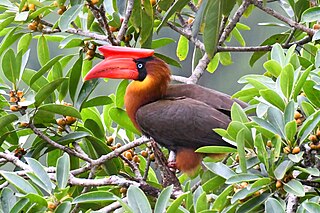
The rufous hornbill, also known as the Philippine hornbill and locally as kalaw, is a large species of hornbill endemic to the Philippines. They are referred by locals as the "clock-of-the-mountains" due to its large booming call which typically occur of every hour. It occurs in moist tropical lowland forest. They are now considered to be a threatened species and its reasons for decline being habitat destruction, hunting and poaching for the illegal pet trade.
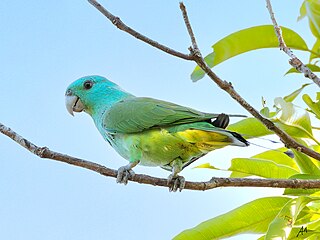
The blue-headed racket-tail, also known as the Palawan racket-tail and locally as kinawihan, is a parrot found in the western Philippines around Palawan. The species was formerly considered conspecific with the blue-crowned racket-tail. It is locally known as 'kilit'. It inhabits humid lowland forest in small flocks. It is threatened by habitat destruction and limited trapping for the cage-bird trade.

The Philippine serpent eagle is an eagle found in the major islands of the Philippines. It is sometimes treated as a race of the crested serpent eagle. This species is usually found in forest clearings, open woodlands, and sometimes in cultivated lands with scattered trees. It is endemic to the Philippines. The species is found on most part of the major islands, except for Palawan.

The black hornbill is a species of bird of the hornbill family Bucerotidae. It lives in Asia in Brunei Darussalam, Indonesia, Malaysia, Singapore, Thailand.

The writhed hornbill, also known as the Mindanao wrinkled hornbill, is a species of hornbill in the family Bucerotidae. It is endemic to primarily lowland forests on the Philippine islands of Mindanao, Dinagat and Camiguin Sur. It formerly included the Walden's hornbill as a subspecies, but unlike that species, both sexes of the writhed hornbill have orange-red throat and peri-ocular skin. The writhed hornbill is threatened by habitat loss and hunting.
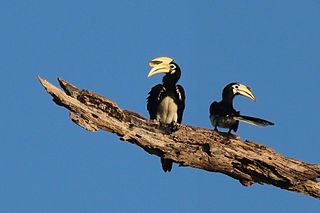
The oriental pied hornbill is an Indo-Malayan pied hornbill, a large canopy-dwelling bird belonging to the family Bucerotidae. Two other common names for this species are Sunda pied hornbill (convexus) and Malaysian pied hornbill.
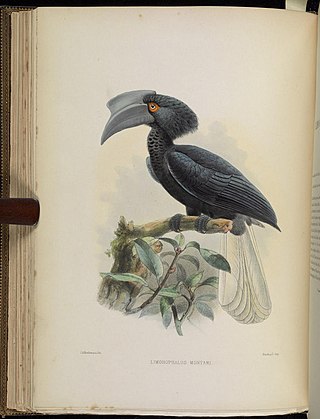
The Sulu hornbill, or Montano's hornbill, is a species of hornbill in the family Bucerotidae. It is endemic to the Sulu archipelago in the Philippines, with the remaining populations in Tawi-Tawi with it believed to be hunted to extinction on Jolo. Its natural habitat is tropical moist forests. It is threatened by habitat loss as well as potential harvesting for food. Its diet includes fruit, insects, and small lizards.
The brown-cheeked hornbill is a species of hornbill in the family Bucerotidae. It is found in Ivory Coast, Ghana, Guinea, Liberia, Sierra Leone, and Togo. Its natural habitats are tropical and subtropical moist broadleaf forests, plantations, and secondary growth forests. It is threatened by habitat destruction, as timber is harvested and the forests become increasingly fragmented.
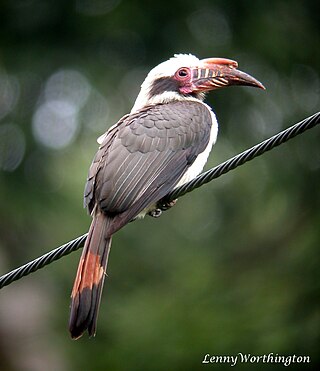
The Luzon hornbill, sometimes called Luzon tarictic hornbill, is a species of hornbill in the family Bucerotidae. It is endemic to forests on Luzon and nearby islands in the northern Philippines. All five Philippine tarictics were once considered a single species. It is declining due to habitat destruction, hunting and the illegal wildlife trade.

The Mindoro hornbill is a species of hornbill in the family Bucerotidae. It is endemic to forests on Mindoro in the Philippines found in tropical moist lowland forests. As is the case with all five Philippine tarictic hornbills, formerly considered to be just one species. It is the only tarictic hornbill where both sexes are creamy-white and black. The sexes are very similar, differing primarily in the colour of the ocular ring. It is threatened by habitat loss, and is consequently considered endangered by the IUCN.

The flame-breasted fruit dove is a species of bird in the family Columbidae. It is endemic to the Philippines where it is only found in the mountains of Luzon. It is the largest fruit dove in the country and rivals the size of Imperial pigeons. It is identified with its red hood, black wings with a red patch on its secondaries and its unmistakable flame-coloured breast. Its natural habitats are in upper areas of the tropical moist lowland forest and in mid to upper montane forest. It is threatened by habitat loss, poaching for the pet trade and hunting for food.

The Palawan flycatcher is a species of bird in the family Muscicapidae. It is endemic to the Philippines found only in the region of Palawan. Its natural habitat is tropical moist lowland forests. It is threatened by habitat loss.

